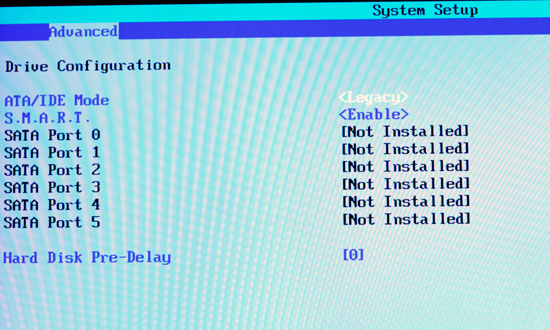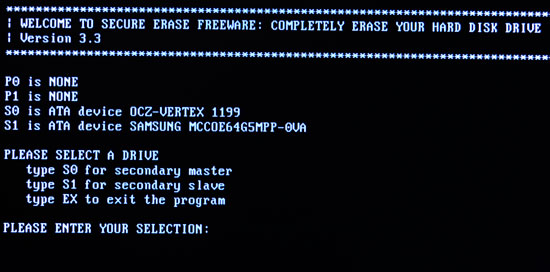The SSD Anthology: Understanding SSDs and New Drives from OCZ
by Anand Lal Shimpi on March 18, 2009 12:00 AM EST- Posted in
- Storage
Restoring Your Drive to Peak Performance
Based on my explanation there’s one sure-fire way to make your drive fast again. Formatting/deleting everything on the drive won’t work because those pages on the drive will remain full of data.
If you are doing a clean setup of your machine and want to restore your drive to its native state you’ll have to perform a secure erase. Intel distributed a tool with the first X25-M review kits called HDD ERASE. This tool will take any SSD and free every last page on the drive. Obviously you’ll lose all of your data but your drive will be super fast again!
In order for HDDERASE to work you need to have your SATA controller running in Legacy IDE mode, you can select this in your BIOS. Your drive will have to be connected to one of the first four SATA ports off of the controller.

Boot to a command prompt (I just use a bootable DOS image on my USB stick) and run the executable. Answer its questions carefully and with honor.



Tell it you would like to perform a secure erase (an extended one isn’t necessary) and when it asks you if you wish to view LBA 0 you can say no. Reboot your machine (don’t forget to set your SATA controller back to whatever mode you had it in before, e.g. RAID or AHCI), partition your drive and you’re back in business.
On a good SSD I don’t believe there’s a need to secure erase periodically, but whenever you format or re-image your drive, I’d recommend a secure erase since you’re killing all of your data anyway.










250 Comments
View All Comments
SkullOne - Wednesday, March 18, 2009 - link
Fantastic article. Definitely one of the best I've read in a long time. Incredibly informative. Everyone who reads this article is a little bit smarter afterwards.All the great information about SSDs aside, I think the best part though is how OCZ is willing to take blame for failure earlier and fix the problems. Companies like that are the ones who will get my money in the future especially when it is time for me to move from HDD to SSD.
Apache2009 - Wednesday, March 18, 2009 - link
i got one Vertex SSD. Why suspend will cause system halt ? My laptop is nVidia chipset and it is work fine with HDD. Somebody know it ?MarcHFR - Wednesday, March 18, 2009 - link
Hi,You wrote that there is spare-area on X25-M :
"Intel ships its X25-M with 80GB of MLC flash on it, but only 74.5GB is available to the user"
It's a mistake. 80 GB of Flash look like 74.5GB for the user because 80,000,000,000 bytes of flash is 74.5 Go for the user point of view (with 1 KB = 1024 byte).
You did'nt point out the other problem of the X25-M : LBA "optimisation". After doing a lot of I/O random write the speed in sequential write can get down to only 10 MB /s :/
Kary - Thursday, March 19, 2009 - link
The extra space would be invisible to the end user (it is used internally)Also, addressing is normally done in binary..as a result actual sizes are typically in binary in memory devices (flash, RAM...):
64gb
128gb
80 GB...not compatible with binary addressing
(though 48GB of a 128GB drive being used for this seems pretty high)
ssj4Gogeta - Wednesday, March 18, 2009 - link
Did you bother reading the article? He pointed out that you can get any SSD (NOT just Intel's) stuck into a situation when only a secure erase will help you out. The problem is not specific to Intel's SSD, and it doesn't occur during normal usage.MarcHFR - Wednesday, March 18, 2009 - link
The problem i've pointed out has nothing to do with the performance dregradation related to the write on a filled page, it's a performance degradation related to an LBA optimisation that is specific to Intel SSD.VaultDweller - Wednesday, March 18, 2009 - link
So where would Corsair's SSD fit into this mix? It uses a Samsung MLC controller... so would it be comparable to the OCZ Summit? I would expect not since the rated sequential speeds on the Corsair are tremendously lower than the Summit, but the Summit is the closest match in terms of the internals.kensiko - Wednesday, March 18, 2009 - link
No, OCZ Summit = newest Samsung controller. The Corsair use the previous controller, smaller performance.VaultDweller - Wednesday, March 18, 2009 - link
So what's the difference?The Summit is optimized for sequential performance at the cost of random I/O, as per the article. That is clearly not the case with the Corsair drive, so how does the Corsair hold up in terms of random I/O? That's what I'm interested in, since the sequential on the Corsair is "fast enough" if the random write performance is good.
jatypc - Wednesday, March 18, 2009 - link
A detailed description of how SSDs operate makes me wonder: Imagene hypothetically I have a SSD drive that is filled from more than 90% (e.g., 95%) and those 90% are read-only things (or almost read-only things such as exe and other application files). The remaining 10% is free or frequently written to (e.g., page/swap file). Then the use of drive results - from what I understood in the article - in very fast aging of those 10% of the SSD disk because the 90% are occupied by read-only stuff. If the disk in question has for instance 32GB, those 10% are 3.2 GB (e.g., a size of a usual swap file) and after writing it approx. 10000 times, the respective part of the disk would become dead. Being occupies by a swap file, this number of reads/writes can be achieved in one or two years... Am I right?